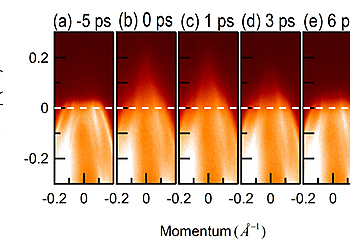A Time- and Angle-Resolved Photoemission Spectroscopy with Probe Photon Energy up to 6.7 eV
Result of the Month
Time- and angle-resolved photoemission spectroscopy (trARPES) enables access into the study of ultrafast electronic dynamics, such as the unoccupied electronic states, relaxation of excited states by electron-electron or electron-phonon interactions, light-induced phase transitions, and more, in superconductors, topological insulators, density wave systems, and other quantum materials.
In trARPES experiments, electrons in occupied states are usually excited into unoccupied states by an infrared femtosecond laser pulse (pump). Thereafter, a femtosecond ultraviolet (UV) pulse (probe) photoemits electrons out of the material. The energy and emission angle of the photoelectrons are the analysed by an electron analyser. Time resolution is achieved by varying the time delay between the pump and probe pulses.
Prof Wentao Zhang et al. have developed a state-of-the-art trARPES instrument based on a Yb-based femtosecond laser and a DA30-L-8000(R) hemispherical electron analyser. The energy of the pump photon is tunable between 1.4 and 1.9 eV, and the pulse duration is around 30 fs. A KBe2BO3F2 nonlinear optical crystal is used to generate probe pulses with a photon energy up to 6.7 eV, and obtain an overall time resolution of 1 ps and energy resolution of 18 meV at an impressive 500kHz repetition rate. In addition, β-BaB2O4 crystals are used to generate alternative probe pulses at 6.05 eV, giving an overall time resolution of 130 fs and energy resolution of 19 meV. In the paper Rev. Sci. Instrum. 90, 063905 (2019) they describe the set-up and illustrate the performance of the system with representative data on several samples (Bi2Se3, YbCd2Sb2, and FeSe).
Regarding the instrumentation and DA30-L-8000 Prof Wentao Zhang states “For sure my system benefits from the low noise detector a lot. For the time-resolved spectra shown in Figs. (b) and (c), it takes 4-5 hours to get such good quality of the data. I previously used an [other brand, editor’s note] analyzer to do the trARPES, but with much longer time (~10 hours) data taken I never see such clear oscillation feature in the spectra. Time resolution and the stability of the laser are also important, but the noise level of the detector is also played a very important role in taking data at such high quality.” He continues: “Due to the good performance of the DA30L-8000 analyser in the very low energy region, it is not necessary to apply bias on the sample for my system for most of the samples we are interested in.”
The new trARPES set-up gives access to important future exploration. Prof Wentao Zhang explains: “With improved energy and time resolution and the stability, we discover the ultrafast purely electronic phase transition in an excitonic insulator and photo-induced hidden phase in a charge density wave material, of which the results will be submitted very soon. I’m pretty sure in the near future there will be a lot of work in the research of manipulating the electronic structure by ultrafast laser. We will extend the pump laser to far infrared region and use new method to get probe laser with much shorter wavelength to probe larger momentum region in solid materials.”
Authors
Yuanyuan Yang,1 Tianwei Tang,1 Shaofeng Duan,1 Chaocheng Zhou,1 Duxing Hao,1 and Wentao Zhang1,2
Institutes
1) Key Laboratory of Artificial Structures and Quantum Control (Ministry of Education), School of Physics and Astronomy, Shanghai Jiao Tong University, Shanghai 200240, China
2) Collaborative Innovation Center of Advanced Microstructures, Nanjing 210093, China
Name and Email of Corresponding Author
Prof Wentao Zhang wentaozhang@sjtu.edu.cn
URL of Insitute web-page
School of Physics and Astronomy Shanghai Jiao Tong University

